
The black-headed gull is a small gull that breeds in much of the Palearctic including Europe and also in coastal eastern Canada. Most of the population is migratory and winters further south, but some birds reside in the milder westernmost areas of Europe. The species also occurs in smaller numbers in northeastern North America, where it was formerly known as the common black-headed gull.
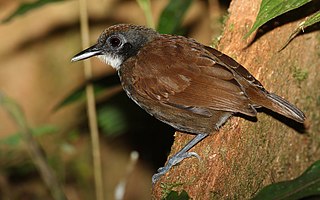
The antbirds are a large passerine bird family, Thamnophilidae, found across subtropical and tropical Central and South America, from Mexico to Argentina. There are more than 230 species, known variously as antshrikes, antwrens, antvireos, fire-eyes, bare-eyes and bushbirds. They are related to the antthrushes and antpittas, the tapaculos, the gnateaters and the ovenbirds. Despite some species' common names, this family is not closely related to the wrens, vireos or shrikes.

The great black-backed gull is the largest member of the gull family. Described by the Cornell Lab of Ornithology as "the king of the Atlantic waterfront", it is a very aggressive hunter, pirate, and scavenger. It breeds on the European and North American coasts and islands of the North Atlantic and is fairly sedentary, though some move farther south or inland to large lakes and reservoirs. The adult great black-backed gull has a white head, neck and underparts, dark grey wings and back, pink legs and yellow bill.
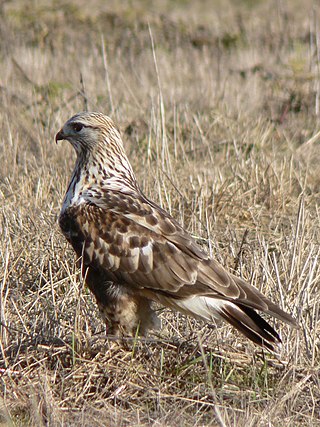
The rough-legged buzzard (Europe) or rough-legged hawk is a medium-large bird of prey. It is found in Arctic and Subarctic regions of North America, Europe, and Russia during the breeding season and migrates south for the winter. It was traditionally also known as the rough-legged falcon in such works as John James Audubon's The Birds of America.

The tree swallow is a migratory bird of the family Hirundinidae. Found in the Americas, the tree swallow was first described in 1807 by French ornithologist Louis Vieillot as Hirundo bicolor. It has since been moved to its current genus, Tachycineta, within which its phylogenetic placement is debated. The tree swallow has glossy blue-green upperparts, with the exception of the blackish wings and tail, and white underparts. The bill is black, the eyes dark brown, and the legs and feet pale brown. The female is generally duller than the male, and the first-year female has mostly brown upperparts, with some blue feathers. Juveniles have brown upperparts, and grey-brown-washed breasts. The tree swallow breeds in the US and Canada. It winters along southern US coasts south, along the Gulf Coast, to Panama and the northwestern coast of South America, and in the West Indies.

A herd is a social group of certain animals of the same species, either wild or domestic. The form of collective animal behavior associated with this is called herding. These animals are known as gregarious animals.

The chacma baboon, also known as the Cape baboon, is, like all other baboons, from the Old World monkey family. It is one of the largest of all monkeys. Located primarily in southern Africa, the chacma baboon has a wide variety of social behaviours, including a dominance hierarchy, collective foraging, adoption of young by females, and friendship pairings. These behaviors form parts of a complex evolutionary ecology. In general, the species is not threatened, but human population pressure has increased contact between humans and baboons. Hunting, trapping, and accidents kill or remove many baboons from the wild, thereby reducing baboon numbers and disrupting their social structure.

Anti-predator adaptations are mechanisms developed through evolution that assist prey organisms in their constant struggle against predators. Throughout the animal kingdom, adaptations have evolved for every stage of this struggle, namely by avoiding detection, warding off attack, fighting back, or escaping when caught.
Apostatic selection is a form of negative frequency-dependent selection. It describes the survival of individual prey animals that are different from their species in a way that makes it more likely for them to be ignored by their predators. It operates on polymorphic species, species which have different forms. In apostatic selection, the common forms of a species are preyed on more than the rarer forms, giving the rare forms a selective advantage in the population. It has also been discussed that apostatic selection acts to stabilize prey polymorphisms.
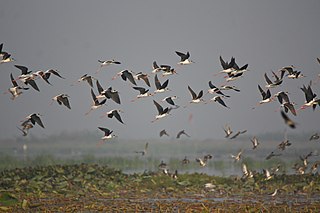
A flock is a gathering of individual birds to forage or travel collectively. Avian flocks are typically associated with migration. Flocking also offers foraging benefits and protection from predators, although flocking can have costs for individual members.

A bird colony is a large congregation of individuals of one or more species of bird that nest or roost in proximity at a particular location. Many kinds of birds are known to congregate in groups of varying size; a congregation of nesting birds is called a breeding colony. Colonial nesting birds include seabirds such as auks and albatrosses; wetland species such as herons; and a few passerines such as weaverbirds, certain blackbirds, and some swallows. A group of birds congregating for rest is called a communal roost. Evidence of colonial nesting has been found in non-neornithine birds (Enantiornithes), in sediments from the Late Cretaceous (Maastrichtian) of Romania.

Nesting behavior refers to an instinct in animals during reproduction to prepare a place with optimal conditions for offspring. The nesting place provides protection against predators and competitors that mean to exploit or kill offspring. It also provides protection against the physical environment.
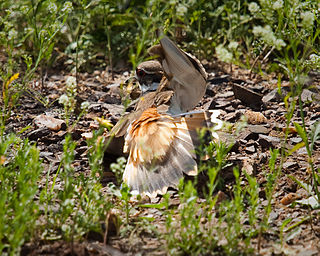
Distraction displays, also known as diversionary displays, or paratrepsis are anti-predator behaviors used to attract the attention of an enemy away from something, typically the nest or young, that is being protected by a parent. Distraction displays are sometimes classified more generically under "nest protection behaviors" along with aggressive displays such as mobbing. These displays have been studied most extensively in bird species, but also have been documented in populations of stickleback fish and in some mammal species.
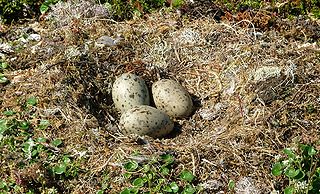
Clutch size refers to the number of eggs laid in a single brood by a nesting pair of birds. The numbers laid by a particular species in a given location are usually well defined by evolutionary trade-offs with many factors involved, including resource availability and energetic constraints. Several patterns of variation have been noted and the relationship between latitude and clutch size has been a topic of interest in avian reproduction and evolution. David Lack and R.E. Moreau were among the first to investigate the effect of latitude on the number of eggs per nest. Since Lack's first paper in the mid-1940s there has been extensive research on the pattern of increasing clutch size with increasing latitude. The proximate and ultimate causes for this pattern have been a subject of intense debate involving the development of ideas on group, individual, and gene-centric views of selection.

Begging in animals is when an animal solicits being given resources by another animal. This is usually a young animal soliciting food from their parents, brood hosts or other adults. However, the resource is sometimes non-food related or may be solicited by adult animals. Begging behavior is most widely studied in birds, however, mammals, amphibians, and invertebrates perform begging displays. Generally in food solicitation, begging behavior is instinctive, although in some instances it is learned.
Vigilance, in the field of behavioural ecology, refers to an animal's monitoring of its surroundings in order to heighten awareness of predator presence. Vigilance is an important behaviour during foraging as animals must often venture away from the safety of shelter to find food. However, being vigilant comes at the expense of time spent feeding, so there is a trade-off between the two. The length of time animals devote to vigilance is dependent on many factors including predation risk and hunger.

The Eurasian goshawk is a species of medium-large bird of prey in the family Accipitridae, a family which also includes other extant diurnal raptors, such as eagles, buzzards and harriers. As a species in the genus Accipiter, the goshawk is often considered a "true hawk". The scientific name is Latin; Accipiter is "hawk", from accipere, "to grasp", and gentilis is "noble" or "gentle" because in the Middle Ages only the nobility were permitted to fly goshawks for falconry.

Egg predation or ovivory is a feeding strategy in many groups of animals (ovivores) in which they consume eggs. Since a fertilized egg represents a complete organism at one stage of its life cycle, eating an egg is a form of predation, the killing of another organism for food.
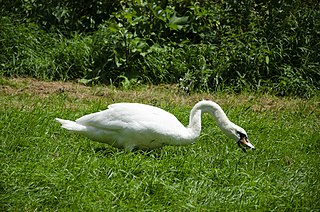
Avian foraging refers to the range of activities and behaviours exhibited by birds in their quest for food. In addition to their unique body adaptations, birds have a range of described behaviours that differ from the foraging behaviours of other animal groups. According to the foraging habitat, birds may be grouped into foraging guilds. Foraging includes a range of activities, starting with the search for food, making use of sensory abilities, and which may involve one or more birds either of a single or even of multiple species. This is followed by locomotion and movements to obtain or capture the food, followed by the processing or handling of the foods prior to ingestion. Like all organisms foraging entails balancing the energy spent and energy gained. The high metabolic rate of birds, among the highest in the homoeotherm groups, constrains them to ensure a net positive gain in energy and have led evolutionary ethologists to develop the idea of optimal foraging.
Dietary conservatism is a foraging strategy in which individuals show a prolonged reluctance to eat novel foods, even after neophobia has been overcome. Within any given population of foragers, some will be conservative and some will be adventurous, an alternative strategy in which individuals readily accept novel food immediately after neophobia has waned. Dietary conservatism and neophobia are however distinct processes, distinguished by the persistence of an individual's reluctance to eat over repeated encounters with novel food and over long time periods.























